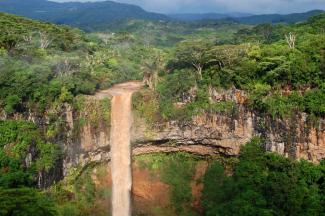Nature conservation
Threatened by invasive species

Please give me a short overview of the state of the forests in Mauritius?
Before Mauritius was colonised around 400 years ago, 90 % of its landmass was covered by forest. The Europeans, starting with the Dutch, cleared the land for timber and plantations. After independence in 1968, more forest was cut down to expand sugar-cane cultivation, Mauritius’ main cash crop. Today, only around two percent of the native forest is left. All in all, 17.2 % of the landmass is forested, but this is mostly invaded forest with exotic species. And the unfortunate trend is that the forest area is decreasing by an annual 0.5 %.
What are the main threats to Mauritius’ forests?
Urbanisation is reducing the remaining green areas of the island, especially along the coast. We have a growing population, and people get wealthier and want to live in their own houses instead of apartments, so many new houses are being built. But the biggest threat to the native forest are exotic invasive species.
What about climate change? Does it have any effects on the forest?
Yes, rainfall patterns are changing, and the temperature is rising. When heavy rains come too early in the year, for example, the trees’ flowers fall down before being pollinated, so they cannot produce seeds and disseminate them. Higher temperatures make insects move to higher or lower altitude, and that too can result in reduced pollination. Moreover, some plants that like cooler temperatures are losing parts of their habitat. The dry season has also become longer: we now experience severe drought from August to December.
Are the remaining forests in Mauritius protected?
We have two national parks and some nature reserves. All in all, 31 % of the forested area is protected, so more than two thirds are unprotected. People may use them as they please.
What does the government do to protect or restore the forests?
Some reforestation is taking place in the national parks and nature reserves, but it is very limited. Our work at Ebony Forest adds to what the government is doing. They support us for example by giving us seedlings that we can plant in our reforestation programme.
Ebony Forest was founded in 2005 with the objective to „save the Mauritian forests“. What do you do to reach that goal?
The founders, a Mauritian-Australian couple with a passion for wildlife, bought 50 hectares of land from their own money. We are turning this land into a forest consisting of native species. So far, 17 hectares have been restored. Our main activity is reforestation. We remove the invasive species first and then plant native ones like ebony trees. That is what gave the company its name. We have 11 endemic species of ebony in Mauritius. We have been doing our work for more than ten years, planting 143 000 plants, most of them trees. In 2018, the forest was ready to serve as a habitat for birds, and we released 50 individuals each of two endemic species, the echo parakeet and the pink pigeon. The pigeons have already had offspring. The birds are important for the forest because they disperse endemic seeds. Next, we plan to release endemic snails and other passerines.
Why do you put such an emphasis on endemic species?
The Mauritian ecosystem is very fragile. The endemic biodiversity is very specific to our isolated island, and it does not cope well with invasive species. Some of the plants that colonists brought to Mauritius grow very fast, so these colonising species have crowded out the native plants. Today, 89 % of the endemic plant species are at risk of extinction. Two invasive species are particularly problematic at Ebony Forest: the Chinese guava and tecoma trees. Adding to the problem, the colonial powers also imported birds from Asia like the red-whiskered bulbul. It feeds on guava and spreads the seeds.
Another part of your programme is education. What is it about?
We work with school children to raise awareness of the value of the forests. They come to Ebony Forest with their teachers and do different kinds of interactive activities, such as planting trees, nursery activities, treasure hunts or quizzes in our natural history museum. The children are our future – it is very important to make them realise how important the forest is. Culturally, people in Mauritius are afraid of the forest, they fear evil spirits said to be living there. But that is changing in the young generation; we can see that there is a growing interest in nature and environment. If we want future generations to fight to protect the country’s natural heritage, then they must experience it early on in an engaging and memorable way. Reconnecting children, as well as adults, to nature is one of our major challenges.
Tourists can visit Ebony Forest and even plant trees themselves. Do you do tourism to raise money for the project?
With the ecotourism component, we want to demonstrate that Mauritius is not only about nice scenery and beautiful beaches. Some tourists who come here don’t know anything about endemic species, so there is an education component to it. But yes, the main goal is to fund our conservation work. Many tourists are impressed by what we do and donate money in addition to what they pay for the tours or other activities. That money is crucial to enable us to complete our conservation mission.
What is your long-term goal?
We want the forest to become a self-sustaining ecosystem, without human intervention. That’s why we bring in pollinators and seed dispersers. The newly afforested areas need to be weeded three to four times a year – that is a lot of work. Once the canopy is closed, we can reduce the weeding frequency, but that takes more than ten years. When the forest has reached that state, only native species will grow back. That’s where we want to get.
Link
Ebony Forest:
www.ebonyforest.com
Nicolas Zuël is conservation manager at Ebony Forest.
nzuel@ebonyforest.com








